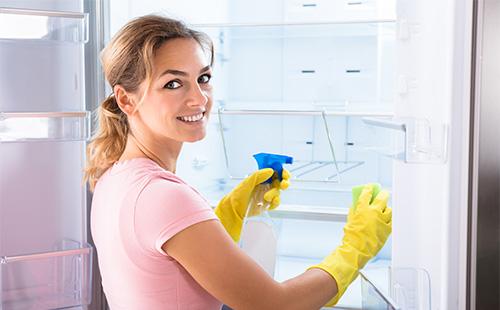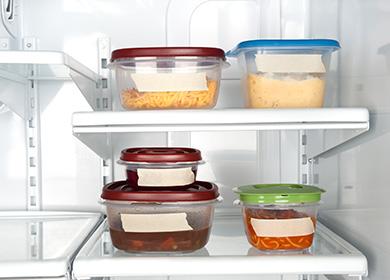The content of the article
Logically, the refrigerator was created in order to lower the temperature of its contents. However, many manufacturers of household appliances warn: if you put hot in the appliance, then it may fail. In addition, this will not be a warranty case, which means that if you remove the grill in the refrigerator, you will have to do the repair at your own expense.
Cooling technology
The cooling rate of products depends on how much a modern refrigerator is used in your kitchen, and by what technology it works. Distinguish the main two. The rest are already combinations and derivatives.
- Static It is also called crying or drip. The main cooling element (evaporator) in such refrigerators is hidden behind the rear wall. The air inside the refrigerator, in contact with this surface, cools and cools the food. Since the temperature of the back wall is quite low, moisture droplets on contact remain on it in the form of ice or a snow coat. As soon as the temperature reaches the set value, the compressor forcing refrigerant into the evaporator is turned off. Condensate thaws and drains into a special container. Since air in static systems circulates naturally inside the chamber, cooling is slow.
- Dynamic. Next-generation No frost refrigerators operate in a different way. The evaporator in such systems is not hidden behind the wall, it is located directly inside the chamber. Due to which, the formation of ice on the walls does not occur. Air by special fans is forcedly “drawn” through the evaporator and evenly circulates throughout the chamber. The process of lowering the temperature of newly added products is much faster.
Danger of sudden changes in temperature in static systems
The standard system used by most manufacturers of refrigerators and freezers involves the formation of frost on the back wall. For this and other reasons, the temperature difference for this technique is very dangerous and leads to the following four problems.
- Compressor wear. In normal mode, the compressor runs hardly more than 10% of the total time of the day, maintaining the temperature set by the user. If you put hot in a refrigerator operating on such a system, the temperature in the chamber will begin to rise sharply. The compressor will be forced to work longer and shut off less frequently in order to maintain the parameters of the set temperature mode. As a result, the wear of the main motor increases several times, which reduces the service life of the refrigerator.
- Unscheduled defrost. Hot products sent to the refrigerator have a high degree of evaporation. Steam will settle on the back wall in the form of hoarfrost in much larger quantities than in normal mode. Ice has low thermal conductivity, so the temperature will gain even more slowly.The compressor will turn off less often, and the self-defrosting system will fail - the “snow coat” will continue to grow. It is necessary to urgently carry out an unscheduled defrost.
- Power consumption. Rise two to three times. This can lead to interruptions in the operation of other devices connected to the network.
- Deformation of the details of the refrigerator. The plastic parts of the refrigerator may melt and leak, impairing its appearance. Due to deformation, the tightness of the door may be impaired, which will result in leakage of cold and additional load on the system.

Hot reaction of the No frost system
If you put warm, hot food or a hot thermos with food in a modern refrigerator using the No frost technology, then of course there will be less harm. Streams of cold air, accelerated by fans, equalize the temperature in the chamber much faster, and on the walls there is no "snow coat" that prevents the cold. This is an undeniable advantage that allows you to cool even hot food without a high risk for technology (of course, it is better not to do this all the time). However, even such a system experiences an additional load, and the device consumes more electricity.
In addition, there are refrigerators with a mixed system. For example, appliances where
according to the No frost principle, only the freezer works, and the remaining compartments are “crying”. Consequently, a hot dish that has fallen on ordinary shelves, and not in freezing, can harm the unit.
2 more reasons to ban
The habit of cooling only boiled soup or a frying pan with sizzling potatoes in the refrigerator can lead not only to problems with cooling systems. Two more reasons not to.
- Corruption of dishes. Modern utensils with Teflon coating or glass can be noticeably affected by sudden cooling. Teflon has a different degree of thermal conductivity and tapers more slowly than the aluminum from which the pans are made. Cracks may result. The same problems exist with ceramic dishes.
- Changing the taste of products. Products in the vicinity of a heat source may lose their properties. The greens will dry out, and the dairy products will deteriorate ahead of time. Also, the taste of many dishes noticeably worsens with sudden cooling. The meat can become tough, and the vegetables in the soup will not have time to reveal the full range of flavors.
3 ways to quickly cool food and drinks
Before you put food in the refrigerator, you need to wait until it has cooled to room temperature. To make the process go faster, use the following three methods.
- Wet towel. Wrap the pan with a towel dipped in cold water and take it out in the sun. When moisture evaporates, the contents of the pan will begin to cool. After drying, wet the towel again.
- Cold water. A hot pan can be “seated” in larger dishes and filled with cold water, thus setting up a water bath on the contrary. To do this, the sink will also fit, the drain of which must first be closed.
- Stirring. Regular stirring and an open lid will also speed up the process.
While the habit of putting hot in the camera is not fixed for you completely, think about it. If you believe experienced, such actions are really fraught with consequences. As a result, an expensive repair or purchase of new equipment can coolly hit your pocket.

Reviews: “It is better to use ice from the freezer”
So it is - it is very harmful for a refrigerator when they put hot food or drinks in it. It is generally not designed for such cruel exploitation. Its task is not to make it hot cold, but to store products that have already cooled down in a constant cool temperature.If you put a hot pot or kettle in it, the temperature rises sharply, and the refrigerator has to work with a strong overload to reduce it to the required level. This is not good for him, and the unit fails, usually at the most inopportune moment. Repair, however, is neither quick nor cheap. For faster cooling, it is better to use ice from a freezer or put a saucepan in cold water (a water bath, on the contrary)
KotoFeya, http://www.lynix.biz/forum/mozhno-li-stavit-goryachuyu-edu-v-kholodilnik
Everything is very simple. Almost all modern refrigerators are automatic systems in which maintaining a reduced temperature is achieved by moving tubes of easily evaporating liquid, for example, freon, through a system of tubes. This movement is provided by an electric motor. When the temperature reaches the set, the sensor turns off the engine. Therefore, the refrigerator does not work constantly, but periodically, and if the unit is in good condition, the engine operating time is no more than 10%.
If you put a hot object in the refrigerator, for example, a saucepan with soup, then the air temperature in the chamber will increase and the engine will work continuously until the temperature is set. That is, half an hour, and an hour, and two in a row, especially if a hot object is near the sensor. At the same time, the moisture evaporated from the hot pan will cool faster and settle on the cooling system in the form of ice and snow, which, as you know, are good heat insulators (it is not for nothing that the Eskimos build a hut from ice - a needle) ...
Due to thermal insulation (ice), the efficiency of the heat removal system will still decrease, which will lead to continuous operation of the engine for several hours, or even days in a row. And the engine is not designed for such a long operation, it will overheat - and the winding will burn. Units imported are less at risk, they are more reliable and have protection against ice, but domestic ones can quite easily fail at the first attempt to cool a pot of boiling water ... Do not believe - check. Repair will convince you :) Good luck!
Andrey Borunov, https://otvet.mail.ru/question/26406267

